Kamol Isroilovich Ibrohimov
Bukhara State Medical Institute, Uzbekistan
Correspondence to: Kamol Isroilovich Ibrohimov, Bukhara State Medical Institute, Uzbekistan.
Copyright © 2023 The Author(s). Published by Scientific & Academic Publishing.
This work is licensed under the Creative Commons Attribution International License (CC BY).
http://creativecommons.org/licenses/by/4.0/

Abstract
In the above-mentioned decisions of the President, it is also necessary to organize livestock feeding in their households based on the activities of the population in cooperation with large livestock farms and processors of their products and to satisfy the demand for livestock feed base, increase the production of livestock products in our country. issues of ensuring food safety are defined as urgent issues.
Keywords:
Nutritional, Chemical, Biological, Social, and hygienic points, Negative effects of harmful factors
Cite this paper: Kamol Isroilovich Ibrohimov, Hygienic Evaluation and Improvement of Working Conditions of Employees of Modern Animal Husbandry Complexes Assistant of the Department of “General Hygiene and Ecology”, American Journal of Medicine and Medical Sciences, Vol. 13 No. 12, 2023, pp. 1964-1970. doi: 10.5923/j.ajmms.20231312.31.
1. Relevance of the Topic
The decision 4243 of the President of the Republic of Uzbekistan dated March 1, 2019, "On further development and support of livestock industries", "On the development of the livestock industry and its industries in the Republic of Uzbekistan in 2022-2026 In the president’s decision 120 of 18.02.2022 on approving the planned program, the president’s decision 5017 on "additional measures for further state support of livestock industries" the issues of further development, providing our people with cheap and high-quality meat and other food products, and financial support of livestock farms have taken a large place. [1,4,5].Animal husbandry is a labor-intensive branch of the national economy. Milk and meat production in special industrial type enterprises requires simplification of product production while reducing manual labor. But the production of meat and milk in most branches of animal husbandry and the accumulation of livestock have fundamentally changed the working conditions of workers working in these enterprises [2,9,10].In recent years, despite the adoption of a number of legal documents on improving working conditions and the introduction of modern mechanization and automated systems in agricultural production, workers in livestock farms were not free from the harmful factors of hard labor production.Today, there is sufficient information about the harmful effects of harmful factors that appear in livestock complexes on the health of workers, about somatic infectious and parasitic diseases that appear under their influence [3,7,8]. However, the complex impact of harmful factors (nutritional, chemical, biological, social) that appear in animal husbandry complexes on the health of workers and the pathological processes that appear among workers as a result of this result from the above, which have not been fully established. Hygienic assessment of the harmful factors that appear in production, determining the level of their impact on the health of workers, and developing measures to improve working conditions are relevant in modern animal husbandry complexes [6,10].The purpose of the research: to check the working conditions of the livestock workers, to evaluate the harmful factors that may appear in the workplace from the hygienic point of view, to scientifically justify and develop a set of measures to prevent the negative effects of harmful factors.Research objects: 180 workers working in livestock complexes belonging to "Bukhara Agrocluster Livestock" limited liability company located in Qarovulbazar district of Bukhara region and "Otabek D" farm of Shofirkon district were taken.
2. Main Part
Research material and methods of examination:The research was conducted in 2021-2023 in livestock complexes belonging to the limited liability company "Bukhara Agro clusterChorva" located in Qarovulbazar district of Bukhara region and the farm "Otabek D" located in Shafirkon district.Livestock complex consists of land for milking, milking, milk processing, slaughtering, preparation of baby milk products, preparation of complex fodder for cattle.180 workers are working in these livestock complexes, 25 of them made up of women. We studied the main and auxiliary production processes.Types and scope of inspection are listed in Table 1.Table 1
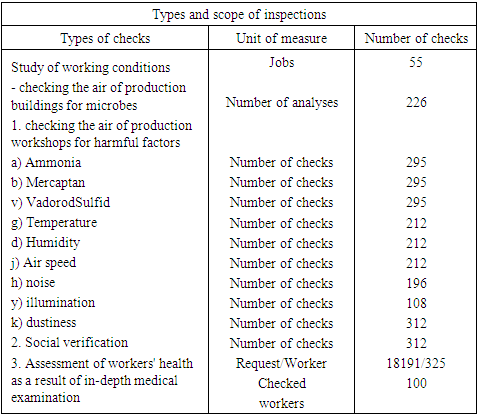 |
| |
|
Hygienic inspections were carried out taking into account the processes related to the care of livestock, milking, slaughtering of animals.-hygienic evaluation of the working conditions of livestock farmers and the air of their workplaces. Such inspections provided an opportunity to evaluate the production factors and workplaces in terms of proven hygiene.In addition to the above, the working conditions of employees working in professions that are auxiliary to the complex (economist, engineer, watchman, clerk, etc.) were studied.Hygienic inspections included studying the level of air pollution of workplaces with harmful substances, microorganisms, and dust, assessing the severity and speed of work of workers working in the main professions.Methods of sanitary and chemical inspection at workplaces.Exceeding the standard amount of gases, especially ammonia, hydrogen sulfide, carbonic anhydrite, mercaptans in the workplaces of animal husbandry complexes, leads to a decrease in the amount of oxygen. They mainly appear as a result of the life activity of livestock and the decomposition of organic substances (food, manure). The amount of constantly generated gases is closely related to the age of livestock, the level and condition of keeping and the efficiency of the air exchangers.GOST 12.1.005- GOST 12.1.005-88 “General sanitary and hygienic requirements for the air of the working area”, GOST R 51569-2000 “Inert dust. Specifications” va Sanitary Rules and Norm№0324-16 “Sanitary and hygienic standards for the microclimate of industrial premises”.The amount of chemical substances in the air of workplaces "Hygienic standards maximum permissible concentrations (MPC) of harmful substances in the air of the working area." Based on Sanitary Rules and Norm0294-11. With the help of the Drager-5600 device, control is carried out selectively in individual working teas from points located in the center and around the room. At this point, the composition of the harmful substance is described according to the following total sampling time: -15 minutes for toxic substances, 30 minutes for fibro genic substances. Over a specified period of time, one or more consecutive samples may be taken at regular intervals. The study of air includes two stages: taking samples and analyzing them.Methods of checking microclimate conditions.Employees working in livestock farms operate for a long time (up to 6-7 hours) in special microclimate conditions, which are defined by zoo technical requirements and are completely different for humans.Microclimate at the workplaces of cattle breeders is implemented at the beginning, middle and end of work. Air temperature and relative humidity were measured using a psychomotor, air movement speed was measured using an anemometer, and heat radiation was measured using an inspection actinometer. The obtained results are evaluated on the basis of sanitary rules and standards 0324-16 entitled "Sanitary Rules and Normof the microclimate of production buildings" and "Hygienic classification of conditional laboratory with indication of the value and uniformity of the factors of the working environment, the load and intensity of the labor process " 0141-03 Sanitary Rules and Norm.Assessment of working conditions depending on the severity of the work process, taking into account all indicators, special working conditions, work conditions that have a specific nature of the work, are determined by increased emotional, mental and nervous tension during the work process, and according to the hygienic classification, level 3 Belongs to class 3. At the same time, the class must first be determined for each measured indicator, and the final assessment of the severity of labor is determined by the indicator that received the highest level of severity. When there are 3 or more indicators of 1 or 2 or 3 degrees of the 2nd class of harmfulness, the severity of work is one step higher (classes 3, 2, 3, 3 and 3, 4, respectively). The assessment of labor intensity is based on the analysis of labor activity and its structure, which are studied through observations over time during the working day, week, etc. The analysis is based on taking into account the entire set of production factors that create the necessary conditions for the excessive occurrence of negative nervous and emotional states.The amount of dust in the workplaces of livestock farms depends on the conditions of keeping livestock and their age. In addition, dust appears in workplaces due to the lack of improvement of maintenance technology, ineffective operation of air exchangers, poor quality cleaning of rooms, and improper design of rooms.The amount of dust in workplaces by aspiration-measurement method (GOST 12.1.005-88 "General sanitary and hygienic requirements for air conditioning and air conditioning systems"; GOST 12.1.04-84- "Working area air" (harmful with indicator tubes the method of measuring the concentration of substances) is carried out. The result of the inspection is evaluated using Sanitary Rules and Norm 0294-11 entitled "Hygienic standards maximum permissible concentrations (MPC) of harmful substances in the air of the working area". The aspirator is suitable for operation at temperatures between 10°C and 35°C, relative humidity up to 80% and atmospheric pressure between 84.0 and 106.7 K/Pa (630 and 800 mm). Air sampling, selection of special filters at a certain speed of air is carried out according to special sanitary-hygienic methods. Selection of filters for sampling is carried out according to special sanitary-hygienic methods. The air passing through the filters leaves impurities in them. The volume of air passing through the filter is determined by knowing the speed of the air and the time of its passage. By determining the amount of impurities in the filters, the amount of impurities per unit of air is determined.Illumination of workplaces is of great importance in keeping the working ability of a person at a high level. Artificial lighting in animal care rooms should be 30-50 lux based on zoo-veterinary requirements.Lighting in workplaces is carried out using Yu-116 photoelectrocalorimeterbased on KMK 2.02.01-98 "Natural and artificial lighting" and GOST 24 940 "Buildings and structures illumination measurement methods". The results of inspections are evaluated on the basis of Sanitary Rules and Norm 0203-06 "Sanitary and hygienic standards of the microclimate of industrial premises".The level of noise and its spectral composition in the workplaces of the livestock farm are measured on the instrument VShV-003 based on GOST 12.1.050-86 "Methods for measuring noise in workplaces and guidelines for measuring and hygienically assessing noise in workplaces". Inspection results are evaluated based on Sanitary Rules and Norm№0325-16 "Orderlies norms of acceptable noise levels in the workplace". Noise is mainly at 10 frequencies in the workplace, control point "A" and 31.5; 63; 125; 250; 500; 1.23.4.8. performed at frequencies.Physiological examination methods.Physiological tests are mainly used to evaluate the state of the body during work, the effect of the production process on the health of workers, work ability and fatigue.Work in industrial livestock farms is characterized by physical pressure on locomotor organs, nervous function, nervous and excretory systems.The severity and intensity of the work of livestock farmers is assessed based on Sanitary Rules and Norm №0141-03 entitled "Hygienic classification of conditional labor indicating the significance and uniformity of the factors of the working environment, the load and intensity of the labor process".The assessment of working conditions, taking into account the joint and combined effects of production factors, is carried out as follows.General assessment of working conditions according to the level of harmfulness and danger:a) according to the highest class and degree of harm;b) if 3 or more factors belong to class 3.1, then the overall assessment of working conditions corresponds to class 3.2;c) When there are two or more factors of classes 3.2, 3.3, 3.4, working conditions are evaluated one level higher, respectively.The activity of the respiratory organs is assessed by measuring the number of breaths and the vital capacity of the lungs using a dry spirometer. In dynamometric tests, the changes in the activity of the members of the base movement are assessed.The examination includes measuring the strength of the finger muscles using a finger dynamometer throughout the work shift. In order to evaluate the symptoms of fatigue of the workers of the enterprise, the continuity of their attention is checked. For this, Platonov's corrector check table is used. Chronoreflexometry allows checking the functional state of the subject's central nervous system by determining the latent time of the subject's motor reaction to the presented visual stimulus. This method allows us to determine the change in the ratio of the main nervous processes (excitation and inhibition), the speed of the nerve impulse along the reflex arc. Reflex reactions are studied in chronoreflexometers, including those included in psychophysiological computer complexes. It is necessary to make determinations in dynamics (before and after the influence of the studied factor). The device of the Platonov table. Attention studies are evaluated using a psychophysiological computer complex with working time with Shulte-Platonov tables, (size of tables 60*60).This experimental psychological test allows you to check the processes of concentration and variability (the speed of conscious transition from one type of activity to another).Hygienic description of the results of inspection of the main harmful factors of production.Cattle care in the livestock complex is assigned to separate groups.The number of workers in groups is determined based on the number of livestock. The main production technology is cattle feeding. Distribution of fodder to livestock is carried out as follows: hay is brought in by machinery and distributed by the worker while the machinery is running. In this case, the worker is under a lot of physical pressure. The figure of the worker is in a forced position, and physical pressure appears on the muscles of the arms, shoulders, and legs.Also, in the process of distributing feed to cattle, high dusting occurs around the workers' respiratory organs. Dusts mainly consist of (plant) dusts.In the open and closed buildings of the complex, the removal of manure and urine is carried out with the help of a conveyor, and the loading of these substances into the conveyor is carried out manually by workers. In this case, the stature of the workers is forced, and the muscles of the arms, shoulders, and legs are subjected to great physical pressure.In the calf care department, workers divide the animals into groups based on their physical condition. Also, they hand-carry prematurely born calves to the isolator. Calves are transferred to mother cows and feeding is also done by hand. In such cases, workers are forced to be in a forced position, and physical pressure occurs on shoulder, arm, and leg muscles.In addition, in the process of sorting calves, there is a high pressure on the organs of vision.Mostly women work in the milking shop. In this case, putting the device on the cow's udder and removing them after milking is done by hand. In this process, women's stature is forced, and physical pressure occurs on shoulder, arm, and leg muscles. Also, female workers are under pressure.Milking of large cattle is done in a special milking parlor. The wall, floor, and ceiling are covered with oil-based paint. A special pit has been established for beheading cattle. The blood flows through a separate channel into the hearth.Cattle are slaughtered manually. Decapitation and skinning are done by hand. In this case, the butchers are subjected to strong physical pressure, their body is forced into a position, and the muscles of the arms, shoulders, and legs are under physical pressure.Also, it is necessary to cut the head of the mole, remove the skin, clean the internal organs, and apply strong pressure to the organs of vision.In addition, butchers are affected by various harmful biological factors (bacteria, viruses, parasites). Among the workers of this workshop, it is inevitable that various types of injuries will appear (fingers are cut, many feet are injured, etc.).Complex meat processing shop of livestock complexes is located in a separate building. In this workshop, the ingredients needed for making omukhta ham are carried to the hopper by hand. This, in turn, creates static and dynamic pressure on workers.Our investigations have shown that chemical substances are the factors that have a harmful effect on workers in this livestock complex.The air in the buildings of livestock complexes is polluted with gas mixtures arising from the decay and decomposition of manure.Hydrogen sulfide and ammonia, mercaptan, indole, and amines are the cause of unpleasant smell in the rooms where livestock are kept.We detected hydrogen sulfide and ammonia mercaptan in the air at workplaces (Table 2).Table 2
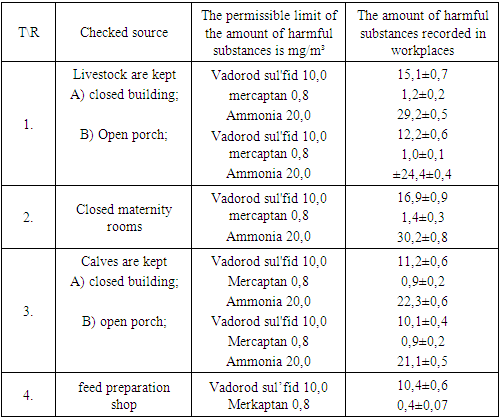 |
| |
|
As can be seen from the figures given in the table, it was observed that the amount of the above-mentioned gases was higher than the specified amount. However, it was noted that the amount of gases from the area where the calves were kept did not exceed the specified standard (Table 2).In closed rooms where dairy cattle are fed for meat and in open terraces, the appropriate ratio of ammonia content is 1.1 and 1.3 times, mercaptan content is 0.9 and 1.2 times, hydrogen sulfide content is 0.8 and 1.0 was noted to have doubled.Hydrogen sulphide and mercaptan ammonia are mainly produced by rotting and decomposition of manure and feed residues in the above-mentioned areas.It was personally observed that the amount of harmful substances recorded in the workplaces of closed buildings where livestock is kept, the amount of hydrogen sulfide, mercaptan, ammonia in the workplaces is higher in the morning hours. (Figure 1)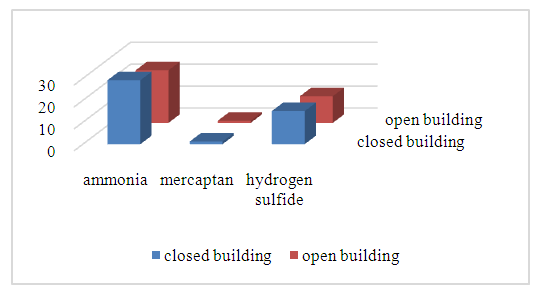 | Figure 1 |
This is due to the fact that the buildings are closed in the evening and the air exchange is low.It should be noted that the concentration of hydrogen sulfide, mercaptan, and ammonia is slightly lower in open verandas than in closed rooms, but their amount is higher than the permissible amount.Dust is one of the factors that negatively affects the health of workers in livestock farms.The amount of dust in livestock complex workplaces (Figure 2).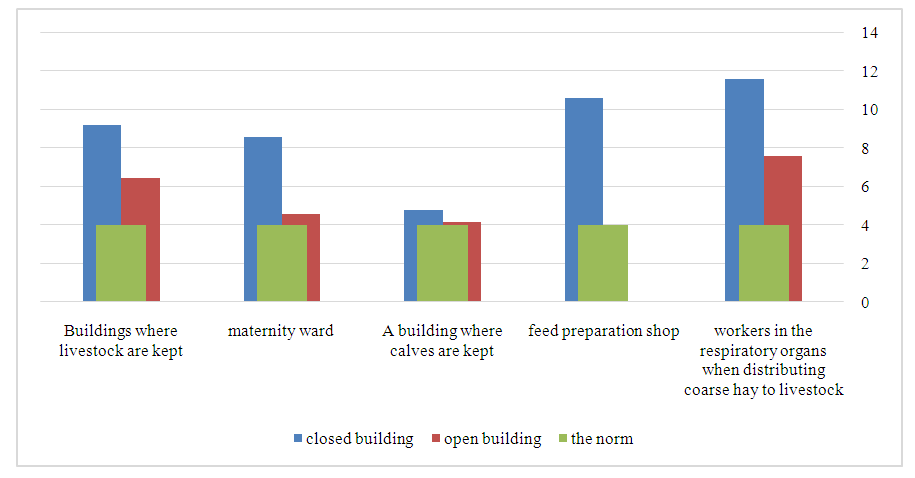 | Figure 2 |
The measurement of the noise level in the main departments of the inspected livestock complex gave the following results (Fig. 3).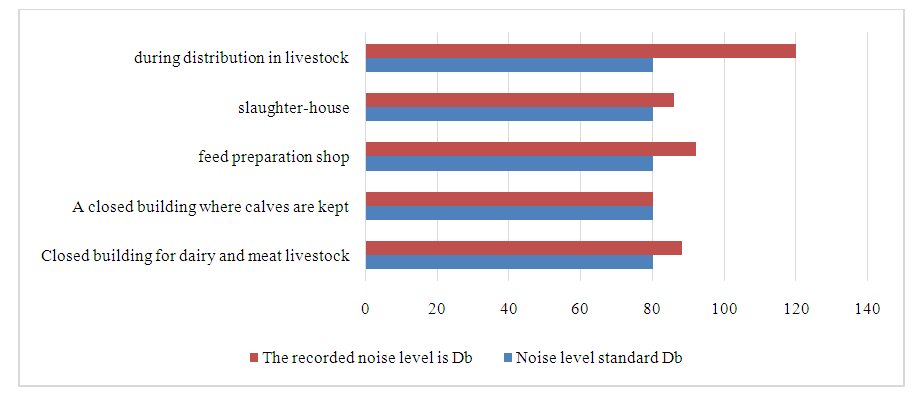 | Figure 3 |
Indicators of noise level in departments of livestock complex.When checking the microclimate parameters in the main production departments of the livestock farm, different indicators of air temperature, humidity and air movement speed were recorded in summer and winter seasons (Table 3).Table 3
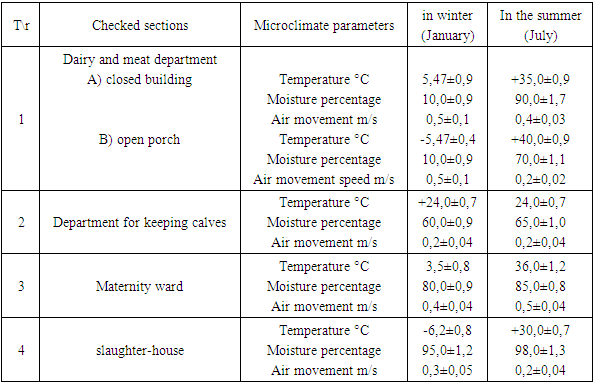 |
| |
|
Microclimate indicators (average) in the main departments of the livestock complex.It was found that the microclimate parameters are different in the main departments of the farm.In the closed section where the livestock kept for milk and meat are stored, the air temperature in winter is -5.4±0.4, in summer the air temperature is +35±0.9, humidity is 90.0±1.2, air movement speed is 0, 4±0.03, the temperature parameter in winter and summer was higher than the specified norm.As a result of installation of a defector device for heating in winter and cooling in summer in the section where calves are kept, it was found that the microclimate parameters did not exceed the specified norm.In addition to the speed of air movement in the maternity ward in winter and summer, it was noted that the temperature and humidity levels do not correspond to the permitted standards.
3. Conclusions
1. During the work of workers of modern animal husbandry complexes, physical, physical, chemical factors of production and harsh working conditions have a complex effect on them. Hygienic assessment of the working conditions of workers working in the main profession is based on them. Corresponds to class 3.1-3.2. The subjective feeling of working conditions and its character on the part of workers corresponds to the objective assessment of the work environment and labor process production factors.2. In the survey of the social questionnaire, 25.5% of the workers admitted that the severity of the working conditions, 69.9% of the workers admitted that their diseases were related to the production environment. A low level of healthy lifestyle among workers: 22.2 percent of workers admitted that they do not engage in physical education, 75 percent of workers work in their personal garden in their free time, that is, they do not have active rest.3. As a result of the medical examination, 62.4% of workers had diseases of the larynx, including 19.4% upper respiratory tract allergies, 38.5% had pathology of peripheral nerves and locomotor organs (19.2%) is recorded. As a result of the analysis, it was proved that these diseases are directly related to high production (p<0.05).The formation of workers' health in modern animal husbandry complexes is primarily influenced by working conditions, secondly by socio-economic factors, and thirdly by lifestyle.
References
| [1] | Bardov, V., Omelchuk, S., Merezhkina, N., Aleksiichuk, V., Anisimov, Y., Antonenko, A., ... & Shevchenko, O. (2022). Hygiene and ecology. |
| [2] | Akhrorovich, O. A. (2022). Hygienic assessment of working conditions and prevention of reproductive pathology among workers of the poultry complex. ACADEMICIA: An International Multidisciplinary Research Journal, 12(1), 161-166. |
| [3] | Naimova, Z. S. (2023). Xenobiotics as a Risk Factor for Kidney and Urinary Diseases in Children and Adolescents in Modern Conditions. Eurasian Research Bulletin, 17, 215-219. |
| [4] | Algorithm for selecting laboratory complexes for early diagnosis of occupational diseases / L.I. Antoshina, I.V. Yatsyna, E.N. Kryuchkova [et al.] // Current problems of safety and risk assessment to public health under the influence of environmental factors: material. All-Russian scientific-practical Conf., with international participation / ed. A.Yu. Popova, N.V. Zaitseva. - Perm, 2014. - pp. 390-395. |
| [5] | Babanov, S.A. Study of the levels of immunoglobulins, fibronectin and myeloperoxidase in dust lung diseases / S.A. Babanov, D.S. Budash // Sanitary doctor. - 2016. - No. 7. - P. 12-20. |
| [6] | Babanov, S.A. Modern approaches to the diagnosis of occupational bronchitis / S.A. Babanov, D.S. Budash // Doctor. - 2016. - No. 2. - P. 14-16. |
| [7] | Bezrukova G.A., Novikova T.A., Spirin V.F., Shalashova M.L., Mikhailova N.A. Hygienic risk factors and prevention of occupational respiratory diseases in livestock workers // Occupational Medicine and Human Ecology. - 2015. - No. 3. – P. 50-64. |
| [8] | Hygienic classification of working conditions according to the degree of harmfulness and danger of factors in the working environment, severity and intensity of the labor process SanPin RUz No. 0141-03 Toshkent 2003 p18. |
| [9] | Hygienic standards - maximum permissible concentrations (MAC) of harmful substances in the air of the working area. SanPiN RUz No. 0294-11 Tashkent - 2011 From 10. |
| [10] | Ngure F, Gelli A, Becquey E, Ganaba R, Headey D, Huybregts L, Pedehombga A, Sanou A, Traore A, Zongo F, Zongrone A. Exposure to Livestock Feces and Water Quality, Sanitation, and Hygiene (WASH) Conditions among Caregivers and Young Children: Formative Research in Rural Burkina Faso. // Am J Trop Med Hyg. 2019 Apr; 100(4): 998-1004. |
| [11] | Ibrohimov K. I. Features of Lobor in Agriculture // Central asian journal of medical and natural sciences. Voleme. – 2022. – Т. 2. – С. 87-91. |
| [12] | Ibrohimov K. I. Incidence rates of livestock complex employees with infectious diseases // barqarorlik va yetakchi tadqiqotlar onlayn ilmiy jurnali. – 2022. – Т. 2. – №. 12. – С. 225-229. |
| [13] | Ibrohimov K. I. Hygienic Assessment of Microclimate Indicators in the Main Departments of the Livestock Complex // International Journal of Studies in Natural and Medical Sciences. -2023. -C. 21-25. |





 Abstract
Abstract Reference
Reference Full-Text PDF
Full-Text PDF Full-text HTML
Full-text HTML

